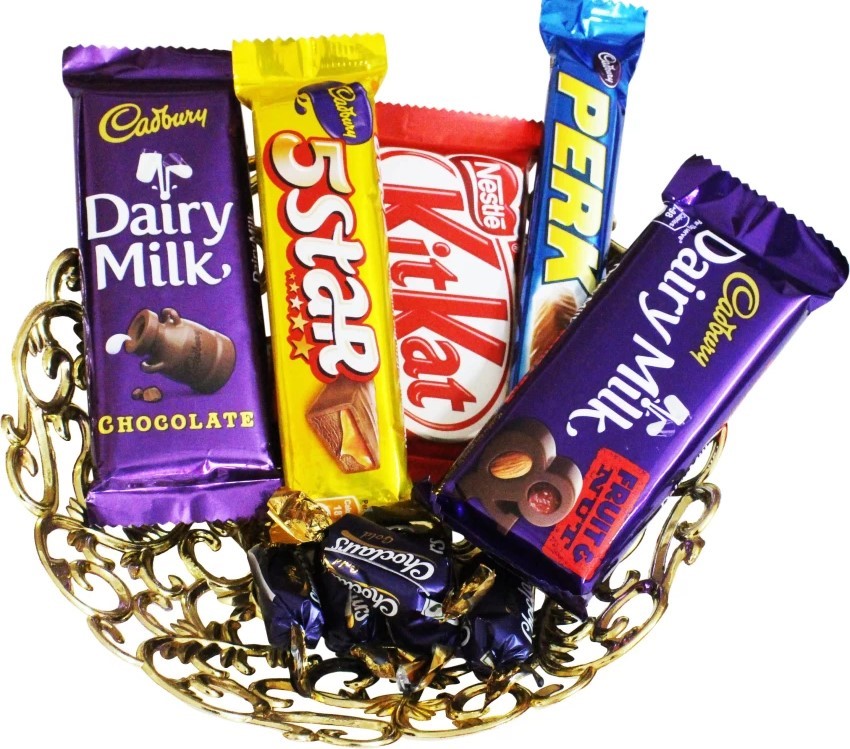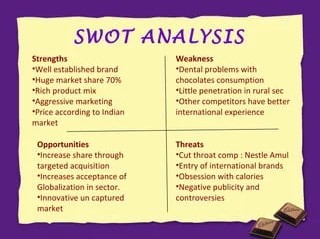
Cadbury Case Study
Introduction:
Cadbury Dairy Milk is a popular brand of milk chocolate made by Cadbury. It first appeared in the UK in 1905 and has since expanded to include various products. All items in the Dairy Milk range are made with pure milk chocolate. In 2014, Dairy Milk was voted the best-selling chocolate bar in the UK.
Initially introduced in England in 1905, Dairy Milk stood out for its higher milk content compared to other chocolate bars of the time. It quickly became Cadbury’s most popular product. George Cadbury Junior, who oversaw its creation, recalled that various names were considered, but “Dairy Milk” stuck after a customer’s suggestion.
The Dairy Milk line expanded over the years. In 1928, “Fruit and Nut” was added, followed by “Whole Nut” in 1933. By then, Cadbury was the leading chocolate brand in the UK. The iconic “glass and a half” slogan, introduced in 1928, highlighted the increased milk content of the bar.
In September 2012, Cadbury decided to change the shape of the bar chunks to circular to reduce weight. This marked the first significant change in the bar’s shape since its inception in 1905. Cadbury had trademarked the distinctive purple colour of their chocolate bar wrappers in 2007, a tribute to Queen Victoria, but Nestlé successfully challenged this in October 2013.
HISTORY
Cadbury has always focused on using milk in their chocolates, as seen in slogans like “a glass and a half of full cream milk in every half pound.” Their commercials often show milk pouring into the chocolate, emphasizing this connection. In 2004, they started airing TV ads in the UK and Ireland featuring people and animals enjoying their chocolates. Dairy Milk was even named the best chocolate bar in the UK in 2014. Ryan Ross oversees the milk aspect of Cadbury’s chocolate.
Cadbury’s story began in 1824 when John Cadbury opened a shop in Birmingham, England, selling tea, coffee, cocoa, and drinking chocolate. He later focused on making cocoa and drinking chocolates, initially targeting the wealthy due to production costs. By the 1900s, Cadbury was advertising its products nationwide.
In 1905, Cadbury introduced Dairy Milk, which became their most famous treat. By 1930, Cadbury had become one of the UK’s largest manufacturers. In 1969, Cadbury merged with Schweppes, a popular British soft drink company, forming Cadbury Schweppes. Eventually, Hershey gained the rights to produce Cadbury candies, leading to the formation of Schweppes Beverages.
In 2008, Cadbury and Schweppes separated their chocolate and beverage businesses. Today, Cadbury produces gum, candy, and, of course, chocolate, operating in over 60 countries with a workforce of over 50,000 employees and thousands of suppliers. Their chocolates are beloved by millions worldwide, making Cadbury a household name in the chocolate industry.
Target Audience of Cadbury
Cadbury’s appeal knows no bounds; it captivates people of all ages and backgrounds. Yet, the company pinpoints particular groups based on various factors like age, location, and lifestyle preferences.
In terms of age, Cadbury caters to everyone – kids, teens, adults, and seniors. Each group finds something special in Cadbury’s offerings, whether it’s the playful packaging for kids, trendy treats for teens, or timeless classics for adults and seniors.
Geographically, Cadbury’s reach extends worldwide, with a strong foothold in places like the UK, Australia, India, and South Africa. They’re also expanding into emerging markets like China and Brazil, where premium chocolates are gaining popularity.
Psychologically, Cadbury targets those who seek joy and indulgence. Their chocolates are synonymous with celebrations and happiness, making them a go-to choice for special occasions and moments of sharing.
Additionally, Cadbury addresses specific consumer needs, like health-conscious individuals and those with dietary restrictions, by offering options like low-sugar and gluten-free treats.
In essence, Cadbury’s diverse and inclusive approach ensures there’s something delightful for everyone. Their success lies in understanding and catering to the unique preferences of different age groups, regions, and consumer segments, making them a beloved brand worldwide.
Let’s break it down further by looking at who each product is meant for based on age.
Age | Product offerings |
Kids | Dairy Milk, BournVita, 5 Star, Fuse, Tang |
Millennials | Silk, Celebrations, Ice Creams |
Adults | Bournville, Temptation, Celebrations, Ice Creams |
Cadbury’s Marketing Strategies: Creating Moments of Joy
Cadbury India is a famous company known for its clever marketing. They’ve run some memorable campaigns that have really stuck in people’s minds and helped boost sales.

Cadbury owes its remarkable success to its trailblazing marketing approaches. From the timeless “Cadbury Dairy Milk” campaign to the recent “Free the Joy” initiative, the company has consistently led the pack in inventive and captivating marketing endeavours. Cadbury’s advertising efforts have transcended mere promotion to become ingrained in popular culture, with many of its commercials achieving viral status.
In the fiercely competitive global chocolate market, Cadbury remains unrivalled. Offering a diverse array of products tailored to diverse tastes and preferences, the company ensures there’s something for everyone. Its unwavering dedication to excellence and ingenuity has enabled it to uphold its status as one of the world’s premier chocolate brands. This serves as a profound testament to the potency of a distinguished brand and the pivotal role played by effective marketing strategies.
Cadbury – Marketing Mix
Cadbury, the renowned chocolate brand, owes much of its success to a well-crafted marketing strategy, blending the essential elements known as the four Ps: product, price, place, and promotion. This strategic mix has been instrumental in shaping Cadbury’s brand identity, expanding its market presence, and solidifying its status as a frontrunner in the chocolate industry worldwide.
Product
Cadbury offers a diverse selection of chocolates, candies, and confectionery treats designed to satisfy a variety of palates. At the heart of their product lineup is their signature Dairy Milk chocolate, celebrated for its velvety texture and decadent flavour. Alongside their timeless classics, Cadbury has introduced inventive delights like their Creme Egg and Oreo chocolates, which have quickly gained popularity among consumers, earning a devoted following.

Price
Cadbury aims to strike a balance between providing quality treats at reasonable prices and offering premium options for those seeking indulgence. Their pricing strategy ensures that their chocolates are competitively priced, appealing to a broad spectrum of consumers. Additionally, Cadbury offers luxury boxed chocolates at higher price points, targeting consumers willing to invest more in top-tier confectionery experiences. This approach allows Cadbury to cater to varying consumer preferences and purchasing power while maintaining its reputation for delivering delightful sweets.
Place
Cadbury makes sure you can find its goodies almost everywhere – in supermarkets, corner stores, and even online. They’ve built a robust network to get their treats to people worldwide. In newer markets, they’ve set up factories to make sure they’re serving up flavours that locals love. So no matter where you are, you can always enjoy a Cadbury treat!
Promotion
Cadbury’s advertising approach revolves around forging deep emotional bonds with its customers. Their ads often feature touching narratives that celebrate happiness, love, and unity, captivating audiences with creativity and freshness. Moreover, Cadbury actively interacts with its audience on social media platforms, encouraging them to share their own Cadbury experiences and stories.
This promotional strategy, combined with Cadbury’s focus on product quality, competitive pricing, and widespread availability, forms a potent marketing mix. It has not only established Cadbury as a global chocolate leader but also ensured its relevance and success in a fiercely competitive market. With its iconic treats, accessible prices, extensive distribution channels, and engaging marketing endeavours, Cadbury looks set to continue enchanting consumers for years to come.
Cadbury – Marketing Campaigns
Cadbury is famous for its creative and captivating marketing initiatives that have resonated with consumers globally. Let’s explore some of the standout marketing campaigns that have played a pivotal role in solidifying Cadbury’s position as a top brand in the confectionery sector.
Cadbury Dairy Milk: Kuchh Khas He Zindagi Mein
One of Cadbury’s earliest advertisements, dating back to the 1990s, featured a cricket match scene where a player hits the ball out of the stadium. In the ad, a young woman enjoying a Cadbury chocolate bar spontaneously joins the celebration on the field, dancing with pure joy.
This advertisement was a refreshing departure from the norm, perfectly capturing the unbridled happiness of the woman as she danced without a care in the world, simply enjoying her chocolate. It broke stereotypes and redefined the joy of indulging in chocolate.
The ad resonated so strongly with audiences that Cadbury recently revived it. In the updated version, a female cricketer smashes a six, and a male spectator rushes onto the field, dancing exuberantly. The iconic slogan “Kuchh Khas He Zindagi Mein” (Something special in life) plays in the background, evoking the same sense of joy and celebration as the original ad.

Cadbury Milk Shots: Mann Mein Laddoo Phoota
Cadbury launched a campaign for its milk shots, which became another memorable and beloved advertisement. It struck a chord with viewers by comparing the chocolate shots to the traditional Indian sweet, laddoo, providing a relatable point of reference. The campaign’s success prompted Ogilvy to create more memorable ads, including the famous “Beta, Mann Mein Doosraa Laddoo Phoota?” series.

Cadbury Dairy Milk Silk: Kiss Me
Using catchy jingles in advertising is a fantastic way to make your brand memorable and enjoyable. Cadbury has successfully utilised this strategy with its “Kiss Me” jingle.
This particular ad campaign, featuring the “Kiss Me” jingle, was introduced for Cadbury Dairy Milk Silk chocolate. Since its inception, the jingle has been incorporated into various advertisements. In one of the earliest “Kiss Me” ads, two young puppeteers are depicted eagerly craving Dairy Milk Silk chocolate to the extent that they start indulging in it during a performance. The ad effectively showcased the irresistible allure of Silk chocolate, creating a high demand for the product

Cadbury Dairy Milk: Meethe Me Kuchh Meetha Ho Jaye
We all recall the charming girl from the advertisement who hesitated to share her Cadbury chocolate with her family during dinner.
This adorable and heartwarming ad struck a chord with Indian families because it tapped into a common concern: What’s for dessert?

Cadbury Dairy Milk Silk: How Far Will You Go For Love?
This was another standout advertisement from Cadbury, specifically aimed at millennials. Released for Valentine’s Day, it was a brilliant move that boosted sales significantly.
The campaign’s message was straightforward: “This Valentine’s Day, how far will you go for your love?” Accompanied by the hashtag #PopYourHeartOut, it effectively romanticised the idea of indulging in Dairy Milk Silk on Valentine’s Day. Additionally, it featured the popular youth icon, Kartik Aryan, adding to its appeal among the target audience.

Cadbury Oreo: Stay Home and Stay Safe
Amidst the challenges of the Covid-19 pandemic, Cadbury introduced a novel and uplifting concept with its Oreo biscuit advertisement. Targeting young children, the ad fostered a sense of playfulness during these uncertain times, featuring the slogan “Make Way for Play.” It was a brilliantly conceived ad that effectively leveraged the prevailing situation of staying at home.

SWOT Analysis of Cadbury
Cadbury strengths
Cadbury’s immense brand power stands as one of its primary assets, outshining competitors like Mars, Nestle, Kraft, Ferrero, Hershey, and Lindt. Its widespread recognition and consumer familiarity transcend borders, making it a leading confectionery brand globally.
Additionally, Cadbury boasts a robust global footprint, operating in numerous countries beyond its UK origins. This international presence not only diversifies its revenue streams but also shields it from significant losses in case of market setbacks, thanks to its multifaceted market presence.
Moreover, Cadbury enjoys the financial stability provided by its parent company, Mondelez International, a titan in the snack industry. This affiliation not only enhances Cadbury’s profitability but also serves as a safety net during challenging times, ensuring its resilience in the face of adversity.
In essence, Cadbury’s key strengths encompass its
iconic brand,
expansive global reach, and
the backing of a prosperous parent company.
Cadbury weaknesses
Cadbury faces several weaknesses that could hinder its growth and market stability. Firstly, its product range is somewhat limited, primarily focused on confectionery items. While these are enjoyed by consumers, diversifying into other categories such as food and beverages could capitalize on emerging trends like healthy eating, securing Cadbury a stronger foothold in the market.
Secondly, Cadbury has encountered issues with product recalls, damaging consumer trust and tarnishing its reputation. Instances where products were recalled due to undisclosed allergens, despite being labeled allergen-free, erode confidence in the brand and could deter future purchases.
Lastly, Cadbury lacks control over its products’ production in the United States, as Hershey Company holds the rights to produce Cadbury chocolate there. This arrangement, dating back to 1988, means Cadbury cannot fully tap into the lucrative American market. Dissatisfied customers often remark that Hershey’s version lacks the original Cadbury taste, further limiting Cadbury’s potential expansion in the US.
In summary, Cadbury’s weaknesses include its restricted product range, issues with product recalls affecting consumer trust, and its lack of control over its products in the US market due to rights held by Hershey Company.
To sum up, Cadbury’s weaknesses are:
Limited product range
Product recalls
Lack of US rights
Cadbury opportunities
Cadbury stands to capitalize on significant opportunities presented by emerging markets. Traditionally, regions like East Asia and Africa held little significance for major food brands like Cadbury. However, the landscape is shifting, driven by globalization and economic development. Rising incomes among consumers in these regions render Cadbury’s products more accessible, opening up new avenues for growth. This expansion into emerging markets not only taps into additional revenue streams but also reflects the company’s adaptability to evolving market dynamics.
Moreover, addressing its limited product range presents another opportunity for Cadbury. By diversifying its offerings beyond confectionery items, such as venturing into food and beverages, Cadbury can not only mitigate this weakness but also unlock further growth potential. Introducing new products broadens Cadbury’s appeal, potentially attracting customers beyond traditional chocolate enthusiasts. The resultant increase in revenue would be a significant boon for the company, underscoring the benefits of such expansion initiatives.
To sum up, Cadbury’s opportunities are:
Emerging markets
Product range expansion
Cadbury threats
Cadbury faces significant threats, with perhaps the most pressing being the sugar tax. Governments worldwide are increasingly considering levying taxes on sugary products, which directly impacts Cadbury’s operations. These taxes inflate manufacturing costs, forcing Cadbury to raise prices on its products. Such price hikes could dissuade consumers from purchasing Cadbury items, leading to a decline in demand and ultimately reducing the company’s profits.
Furthermore, Cadbury is vulnerable to shifting food trends. As the market gravitates towards healthier eating habits, Cadbury’s focus solely on confectionery presents a challenge. Health-conscious consumers are less inclined to purchase Cadbury’s products, and even when they do, it’s unlikely to be on a regular basis. This shift in consumer preferences towards healthier options threatens to diminish demand for Cadbury’s offerings.
To sum up, Cadbury’s threats are:
Sugar tax
New food trends
SWOT analysis of Cadbury summary
Cadbury Strengths: ● Strong brand ● Global presence ● Ownership by a wealthy family | Cadbury Weaknesses: ● Limited product range ● Product recalls ● Lack of US rights |
Cadbury Opportunities: ● Emerging markets ● Product range expansion | Cadbury Threats: ● Sugar tax ● New food trends |

Cadbury Competitors
In the global market, Cadbury contends with formidable competition from a variety of renowned brands, spanning from well-established giants to newer entrants, all vying for market dominance. Here are some of Cadbury’s primary competitors:
Mars, an American multinational corporation renowned for its diverse array of confectionery offerings, such as M&M’s, Snickers, and Twix.
Hershey’s, an iconic American chocolate and confectionery manufacturer celebrated for its classic Hershey’s Milk Chocolate bars.
Nestle, a Swiss conglomerate recognized for its extensive range of chocolate and other food and beverage products, including Kit Kat and Smarties.
Ferrero Rocher, an Italian luxury chocolate brand esteemed for its premium assortments like Ferrero Rocher and Kinder.
Toblerone, a Swiss chocolate label famed for its distinctive triangular-shaped bars, featuring a blend of Swiss milk chocolate and nougat.
While each competitor boasts its own distinct brand identity and product portfolio, they collectively vie for a piece of the global confectionery market, an arena where Cadbury has maintained a robust presence over the years.
How is Cadbury different from its competitors?
Cadbury distinguishes itself from its competitors in several ways:
Unique Taste: Cadbury’s hallmark is its distinct taste, characterised by its rich and creamy chocolate flavour crafted from top-notch ingredients. This unique taste has long been a key selling point for the company.
Product Range: Cadbury boasts a diverse array of offerings, spanning from chocolate bars to candies, gummies, and baking chocolates. This wide product range enables Cadbury to cater to a broad spectrum of customer preferences and needs.
Company History: With a legacy dating back to 1824, Cadbury possesses a rich historical background that sets it apart from competitors. Nearly two centuries of chocolate-making expertise have established Cadbury as a venerable and trusted brand in the market.
Innovation: Cadbury is celebrated for its innovative approach to product development. Continuously pushing boundaries, the company experiments with novel flavours and product variants, such as the successful collaboration with Oreo in Dairy Milk, to meet evolving consumer tastes.
Social Responsibility: Cadbury prioritises social responsibility, undertaking initiatives to reduce its environmental impact, enhance the livelihoods of cocoa farmers, and advocate for sustainable sourcing practices. This commitment to ethical practices resonates with socially conscious consumers and distinguishes Cadbury as a responsible corporate citizen.
Conclusion
In summary, Cadbury is a well-known brand famous for its tasty chocolates. It has been around for a long time and is loved by people all over the world. While it faces challenges like competition and new rules about sugar in food, it also has strong points like its famous taste, lots of different products, and efforts to help farmers and protect the environment. By focusing on what it does best and keeping up with changes, Cadbury can keep making yummy treats that people enjoy for years to come.







